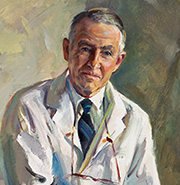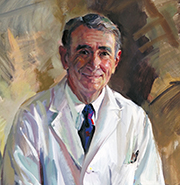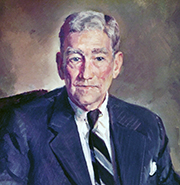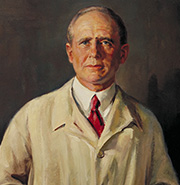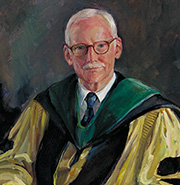William Franklin Draper
1902-2003
Draper was born in Hopedale, Massachusetts. After first studying piano, he chose a career in painting. Draper attended the Pomfret School in Connecticut and later Harvard University. After Harvard, he attended the National Academy of Design in New York and the Cape Art School in Massachusetts. Following his education, he went to Spain to study briefly and then moved to France, where he attended the Académie de la Grande Chaumière. In 1937, he studied sculpture with George Demetrius, a Boston sculptor, and Jon Corbino in New York.
In 1942, Draper entered the Naval Reserves as a lieutenant. After initial training, he was assigned to the Anti-Submarine Warfare Unit in Boston. Following his service in Boston, he transferred into the Naval Art Section and was dispatched to Alaska, where he spent nearly half a year painting in the Aleutian Islands. He was in Amchitka when the Japanese invaded during World War II, and his paintings depict the attacks, as seen from his close-range foxhole. He also painted noncombat images of soldiers at work and play.
After Draper returned from Alaska, he was requested as the artist for the portrait of Rear Admiral J.R. Beardall, then Superintendent of the U.S. Naval Academy. Following the completion of the portrait, he served in a variety of other areas in the Pacific, and was commissioned to paint portraits of several other admirals. While assigned to the USS Yorktown, he painted the series of air attacks on Palau, the landings at Hollandia, and the airstrikes on Truk island. Draper also covered invasions of Saipan and Guam aboard the USS Tennessee.
In 1944, National Geographic reproduced twenty-five of his war images in four issues. In 1945, the Corcoran Gallery of Art in Washington organized an exhibition of works by five official war artists including Draper, and in the same year the Metropolitan Museum included him in a show called The War Against Japan.
Draper was awarded the Bronze Star for his Naval services and left the Navy in 1945 as a Lieutenant Commander. After the war, Draper established a studio on Park Avenue in New York and began his career in portraiture. He became a well-known American artist who painted over 700 portraits, including Richard M. Nixon, the Shah of Iran, James Michener, Henry Kaiser, and Dr. Richard E. Winter. A portrait he did of John F. Kennedy based on an oil sketch hangs in the National Portrait Gallery in Washington.
In 1999, Draper received a lifetime achievement award from the Portrait Society of America. In 2000, he was featured in a PBS television special on combat artists called They Drew Fire.
Portrait(s) by William Franklin Draper
"*" indicates required fields

